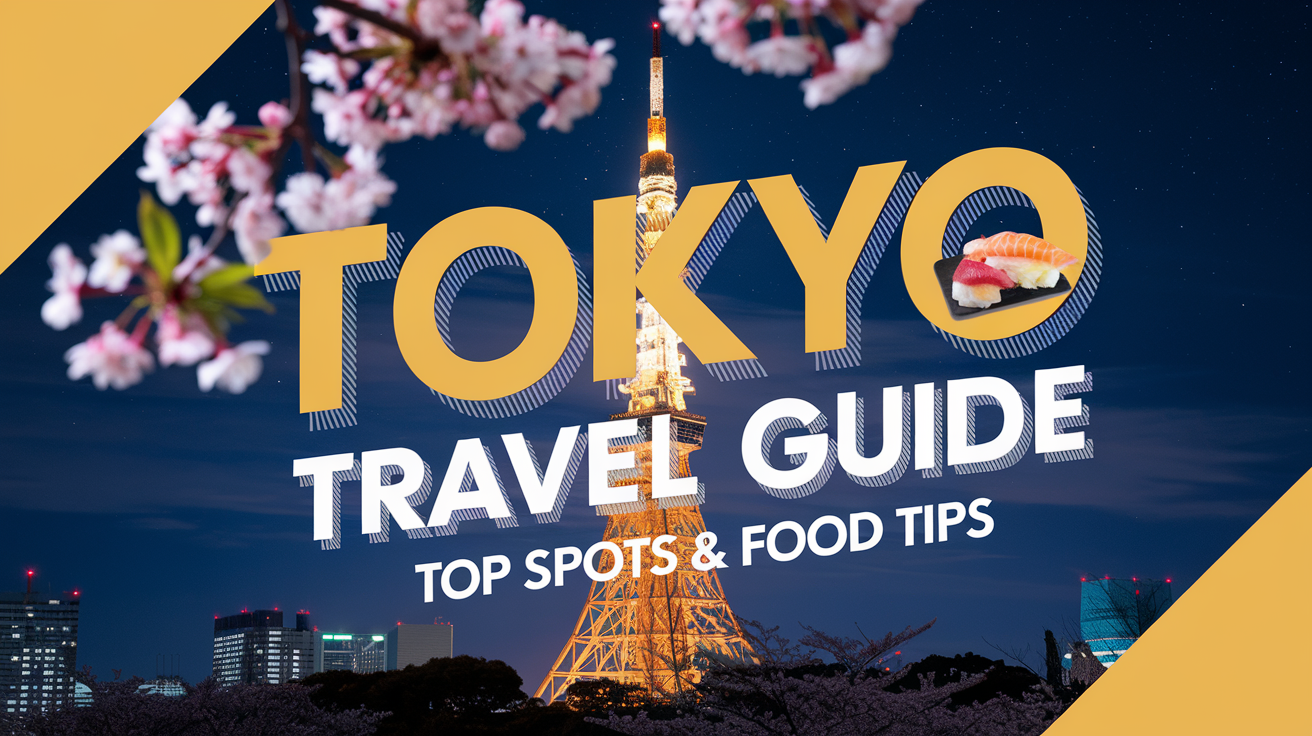Tokyo, Japan’s vibrant capital, combines historic temples, bustling shopping districts, and modern skyscrapers, creating an unforgettable cityscape. This guide covers Tokyo’s top 20 attractions, complete with historical insights, visitor information, ticket prices, and dining recommendations. Whether you’re visiting iconic landmarks or exploring hidden gems, this guide has you covered!
1. Tokyo Tower
Description: Tokyo Tower, inspired by the Eiffel Tower, offers panoramic views of Tokyo from its observation decks.
History: Built in 1958, it symbolized Japan’s post-war rebirth.
Google Maps Link: Tokyo Tower Location
Tickets: Main Deck: 1,200 yen; Top Deck Tour: 3,000 yen. Tokyo Tower Tickets
Nearby Restaurants: *Tokyo Shiba Tofuya Ukai* – traditional Japanese tofu in a garden setting.
Additional Tips: Visit at sunset for the best views.
2. Senso-ji Temple
Description: Tokyo’s oldest temple, Senso-ji is a beautiful, historical site with a bustling shopping street, Nakamise-dori.
History: Founded in 645 AD, it’s dedicated to Kannon, the goddess of mercy.
Google Maps Link: Senso-ji Location
Nearby Restaurants: *Asakusa Imahan* – famous for sukiyaki (Japanese hot pot).
Additional Tips: Early morning or late evening visits offer a peaceful experience.
3. Shibuya Crossing
Description: Known as the busiest pedestrian crossing, Shibuya Crossing embodies Tokyo’s bustling energy.
History: This famous intersection became a global icon of Tokyo’s urban culture.
Google Maps Link: Shibuya Crossing Location
Nearby Restaurants: *Uobei Shibuya Dogenzaka* – fast, affordable sushi on a conveyor belt.
Additional Tips: Best viewed from the Starbucks on the second floor or Shibuya Scramble Square.
4. Meiji Shrine
Description: A serene Shinto shrine nestled in a forest, dedicated to Emperor Meiji and Empress Shoken.
History: Built in 1920 to honor the spirits of the emperor and empress.
Google Maps Link: Meiji Shrine Location
Nearby Restaurants: *Bills Omotesando* – known for delicious pancakes and brunch.
Additional Tips: Visit during New Year’s celebrations for a cultural experience.
5. Tsukiji Outer Market
Description: Known for fresh seafood and local street food, Tsukiji Outer Market is a paradise for food lovers.
History: Once home to the famous wholesale market, it now focuses on retail and dining.
Google Maps Link: Tsukiji Outer Market Location
Nearby Restaurants: *Daiwa Sushi* – serves some of the freshest sushi.
Additional Tips: Arrive early for the best selection of fresh fish.
6. Akihabara
Description: Tokyo’s anime and electronics hub, perfect for gamers, tech enthusiasts, and anime fans.
History: Developed after WWII as a center for electronics, Akihabara grew into an anime haven.
Google Maps Link: Akihabara Location
Nearby Restaurants: *Maach Ecute Kanda Manseibashi* – offers cafes and dining with river views.
Additional Tips: Don’t miss the themed cafes like Gundam Café and Maid Cafés.
7. Ueno Park and Zoo
Description: A popular park with a zoo, museums, and cherry blossoms in spring.
History: Established in 1873, Ueno Park was Japan’s first public park.
Google Maps Link: Ueno Park Location
Tickets: Ueno Zoo: 600 yen. Ueno Zoo Website
Nearby Restaurants: *Iriya Plus Café* – known for Japanese desserts and a cozy atmosphere.
Additional Tips: Great spot for cherry blossom viewing in late March to early April.
8. Ginza Shopping District
Description: Tokyo’s upscale shopping district with luxury stores, boutiques, and cafes.
History: Ginza became a symbol of modernity in Japan, with major redevelopment in the 19th century.
Google Maps Link: Ginza Location
Nearby Restaurants: *Ginza Kyubey* – high-end sushi, considered some of Tokyo’s best.
Additional Tips: Weekends are car-free on Chuo-dori, making it easier to explore on foot.
9. Imperial Palace and East Gardens
Description: The official residence of Japan’s Imperial Family, with beautiful public gardens.
History: Former site of Edo Castle, now a blend of history and nature.
Google Maps Link: Imperial Palace Location
Nearby Restaurants: *Marunouchi Building* – a variety of restaurants with views of the palace.
Additional Tips: The East Gardens are open to the public, free of charge.
10. Tokyo Skytree
Description: Japan’s tallest structure with observation decks offering panoramic views of the city.
History: Opened in 2012, it’s a landmark of Tokyo’s modernization.
Google Maps Link: Tokyo Skytree Location
Tickets: Tickets start at 2,100 yen. Tokyo Skytree Tickets
Nearby Restaurants: *Solamachi dining area* offers diverse Japanese and international options.
Additional Tips: Visit at sunset for spectacular views.
11. Roppongi Hills
Description: Roppongi Hills is a modern development in Tokyo with shopping, dining, and cultural sites, including the famous Mori Art Museum.
History: Opened in 2003, Roppongi Hills has become a popular area for art, shopping, and nightlife.
Google Maps Link: Roppongi Hills Location
Tickets: Mori Art Museum entrance: 1,800 yen. Roppongi Hills Website
Nearby Restaurants: *Gonpachi* – This restaurant, known for its role in the movie “Kill Bill,” serves Japanese izakaya-style dishes.
Additional Tips: The Sky Deck offers great panoramic views of Tokyo, especially beautiful at night.
12. Odaiba
Description: An artificial island featuring attractions like TeamLab Borderless, DiverCity Tokyo Plaza, and the famous life-sized Gundam statue.
History: Built in the 1990s, Odaiba was designed as a futuristic residential and commercial area.
Google Maps Link: Odaiba Location
Tickets: TeamLab Borderless: 3,200 yen. TeamLab Borderless Tickets
Nearby Restaurants: *Sushi no Midori* – Known for fresh, affordable sushi.
Additional Tips: The best time to visit is in the evening for views of the illuminated Rainbow Bridge.
13. Harajuku’s Takeshita Street
Description: A popular street known for its unique fashion boutiques, colorful shops, and trendy cafes.
History: Takeshita Street has been a hub of youth fashion and culture since the 1970s.
Google Maps Link: Takeshita Street Location
Nearby Restaurants: *Marion Crêpes* – Famous for its sweet and savory Japanese-style crepes.
Additional Tips: Visit on weekdays to avoid crowds and fully enjoy the vibrant street scene.
14. Shinjuku Gyoen National Garden
Description: One of Tokyo’s most beautiful gardens, with wide lawns, ponds, and cherry blossom trees.
History: Originally a residence for the samurai in the Edo period, it became a public garden in 1949.
Google Maps Link: Shinjuku Gyoen Location
Tickets: 500 yen. Shinjuku Gyoen Website
Nearby Restaurants: *Tsunahachi* – A highly recommended spot for tempura.
Additional Tips: Spring is the best time to visit for cherry blossoms, while autumn brings beautiful fall colors.
15. Nakamise Shopping Street
Description: A traditional shopping street near Senso-ji Temple, lined with shops selling souvenirs and street food.
History: This shopping street dates back to the Edo period, making it one of Tokyo’s oldest markets.
Google Maps Link: Nakamise Street Location
Nearby Restaurants: *Kikko Asakusa* – A cozy spot for Japanese barbecue near Senso-ji.
Additional Tips: Try the melon pan (a sweet bread) and ningyo-yaki (small, filled cakes), popular snacks on Nakamise.
16. Yasukuni Shrine
Description: A historical Shinto shrine dedicated to honoring those who died in service of Japan.
History: Established in 1869 by Emperor Meiji, the shrine has a museum with wartime exhibits.
Google Maps Link: Yasukuni Shrine Location
Nearby Restaurants: *Kudan Shita Saryo* – Known for Japanese sweets and a serene atmosphere.
Additional Tips: The shrine is surrounded by beautiful cherry blossoms in spring, making it a peaceful spot for viewing.
17. National Museum of Emerging Science and Innovation (Miraikan)
Description: A cutting-edge science museum featuring exhibits on robotics, artificial intelligence, and space exploration.
History: Opened in 2001, Miraikan aims to explore the future of science and technology.
Google Maps Link: Miraikan Location
Tickets: 630 yen. Miraikan Website
Nearby Restaurants: *DiverCity Tokyo Plaza* – A shopping mall with a variety of food options nearby.
Additional Tips: Don’t miss the interactive robot exhibits and ASIMO, the humanoid robot.
18. Shimokitazawa
Description: Known for its indie vibe, Shimokitazawa is full of vintage shops, cafes, and a laid-back atmosphere.
History: This district became popular after WWII and has since attracted artists and musicians.
Google Maps Link: Shimokitazawa Location
Nearby Restaurants: *Bear Pond Espresso* – A specialty coffee shop famous for its expertly brewed espresso.
Additional Tips: Great for thrifting and café hopping, Shimokitazawa is best explored on foot.
19. Edo-Tokyo Museum
Description: A museum dedicated to the history and culture of Tokyo, from the Edo period to modern times.
History: Opened in 1993, this museum is an architectural and cultural highlight of Tokyo.
Google Maps Link: Edo-Tokyo Museum Location
Tickets: 600 yen. Edo-Tokyo Museum Website
Nearby Restaurants: *Chanko Tomoegata* – A restaurant specializing in chanko nabe, a hearty hot pot often eaten by sumo wrestlers.
Additional Tips: Spend a few hours here to fully explore the museum’s interactive exhibits and historical models.
20. Ryogoku Kokugikan
Description: Tokyo’s main sumo arena, home to sumo tournaments held three times a year.
History: Established in 1985, Ryogoku Kokugikan is a significant venue for Japan’s national sport, sumo.
Google Maps Link: Ryogoku Kokugikan Location
Tickets: Prices vary by seat location. Sumo Tickets
Nearby Restaurants: *Yoshiba* – Offers chanko nabe, the traditional sumo wrestler hot pot.
Additional Tips: Book tickets in advance for tournaments, as seats can sell out quickly.
Conclusion
Tokyo is a city that captures the essence of Japan’s rich cultural heritage and modern innovations. From the spiritual ambiance of Meiji Shrine to the bustling excitement of Shibuya Crossing, there’s something here for everyone. This guide provides everything you need to explore Tokyo’s top attractions, including history, visiting tips, and local dining recommendations. We hope you enjoy your journey through Japan’s vibrant capital!




